Estimation of Methane Emissions from Rice Paddies in the Mekong Delta Based on Land Surface Dynamics Characterization with Remote Sensing
Abstract
1. Introduction
2. Materials and Methods
2.1. Sites Along with the Collection of Field Data and HIERARCHICAl Bayesian Modeling of CH4 Emissions
2.2. Earth Observation Datasets and Their Preprocessing Methods
2.3. Inundation/Noninundation Classification Methods on Paddy Soils Covered by Rice Plants
3. Results
3.1. Hierarchical Bayesian Models of CH4 Emissions Based on Satellite-Sensed Phenology/Inundation Variables
3.2. Characteristics of PALSAR-2 Quadruple Microwave Scattering in Inundated/Noninundated Rice Paddies
3.3. Inundation/Noninundation Classification with PALSAR-2-ScanSAR Data and Its Validation
4. Discussion
4.1. Hierarchical Bayesian Models of CH4 Emissions Based on Satellite-Sensed Phenology/Inundation Variables
4.2. Characteristics of PALSAR-2 Quadruple Microwave Scattering in Inundated/Noninundated Rice Paddies
4.3. Inundation/Noninundation Classification with PALSAR-2-ScanSAR Data
4.4. Comparison of PALSAR-2-ScanSAR LSWC with the Other Satellite Sensors
5. Conclusions
Supplementary Materials
Supplementary File 1Author Contributions
Funding
Acknowledgments
Conflicts of Interest
Appendix A
| Site Name | Flux Observation Frequency | Number of Observation Plots | Observation Period |
|---|---|---|---|
| Thot Not | once per 1–7 days | 18 plots/cropping | 2012–2017 (16 cropping) |
| Chau Thanh | once per 1 week | 27 plots/cropping (2013–2014) 6 plots/cropping (2015–2016) | 2013–2014 (6 cropping) 2015–2016 (6 cropping) |
| Cho Moi | once per 1 week | 6 plots/cropping (2015–2016) | 2015–2016 (6 cropping) |
| Thoai Son | once per 1 week | 6 plots/cropping | 2015–2016 (6 cropping) |
| Tri Ton | once per 1 week | 6 plots/cropping | 2015–2016 (5 cropping) |
| 0–20 Days after Sowing | 21–40 Daysafter Sowing | 41–60 Daysafter Sowing | 61–105 Daysafter Sowing | FallowPaddies | Total | |
|---|---|---|---|---|---|---|
| Inundated Paddies | 48 | 30 | 40 | 32 | 16 | 166 |
| Noninundated Paddies | 36 | 28 | 26 | 30 | 27 | 147 |
Appendix B

Appendix C
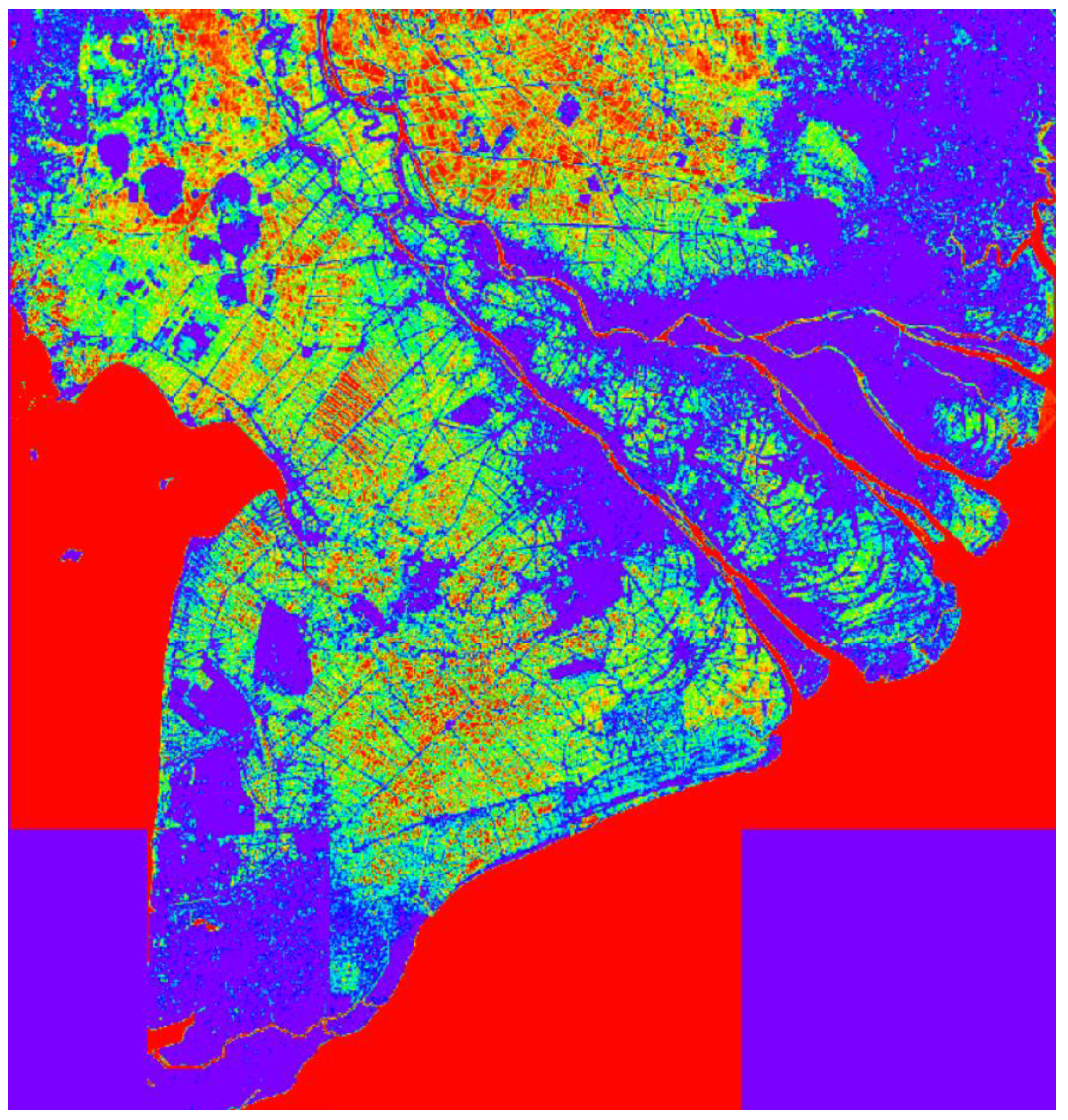
References
- Ciais, P.; Sabine, C.; Bala, G.; Bopp, L.; Brovkin, V.; Canadell, J.; Chhabra, A.; DeFries, R.; Galloway, J.; Heimann, M.; et al. The Physical Science Basis. Contribution of Working Group I to the Fifth Assessment Report of the Intergovernmental Panel on Climate Change; Stocker, T.F., Qin, D., Plattner, G.K., Tignor, M.M.B., Allen, S.K., Boschung, J.B., Nauels, A., Xia, Y., Bex, V., Midgley, P.M., Eds.; Cambridge University Press: Cambridge, UK; New York, NY, USA, 2013. [Google Scholar]
- Schaefer, H.; Fletcher, S.E.M.; Veidt, C.; Lassey, K.R.; Brailsford, G.W.; Bromley, T.M.; Dlugokencky, E.J.; Michel, S.E.; Miller, J.B.; Levin, I.; et al. A 21st-century shift from fossil-fuel to biogenic methane emissions indicated by 13 CH4. Science 2016, 352, 80–84. [Google Scholar] [CrossRef] [PubMed]
- Smith, P.; Martino, D.; Cai, Z.C.; Gwary, D.H.J. Greenhouse gas mitigation in agriculture. Philos. Trans. R. Soc. B Biol. Sci. 2008, 363, 789–813. [Google Scholar] [CrossRef] [PubMed]
- Alexandratos, N.; Bruinsma, J. World Agriculture towards 2030/2050: The 2012 Revision; ESA Working paper; FAO: Rome, Italy, 2012; Volume 12. [Google Scholar]
- FAOSTAT. FAO Statistical Databases. Available online: http://faostat.fao.org/ (accessed on 23 January 2017).
- General Statistics Office of Viet Nam. Statistical Yearbook of Vietnam 2014; Statistical Publishing House: Hanoi, Vietnam, 2014. [Google Scholar]
- Son, N.T.; Chen, C.F.; Chen, C.R.; Duc, H.N.; Chang, L.Y. A phenology-based classification of time-series MODIS data for rice crop monitoring in Mekong Delta, Vietnam. Remote Sens. 2013, 6, 135–156. [Google Scholar] [CrossRef]
- Arai, H. The Anthropogenic Greenhouse Gas Emission from Tropical High Carbon Reservoirs. Chiba University Library Online Public Library Catalog. 2015. Available online: http://opac.ll.chiba-u.jp/da/curator/900119174/HMA_0068.pdf (accessed on 11 April 2018). (In Japanese).
- Arai, H.; Takeuchi, W.; Oyoshi, K.; Nguyen, L.D.; Tachiba, T.; Inubushi, K. Regional evaluation on greenhouse gas-mitigation & yield-increase performance of a water-saving irrigation practice’s dissemination in rice paddies in the Mekong Delta. Monit. Glob. Environ. Disaster Risk Assess. Space IIS Forum Proc. 2018, 26, 43–50. [Google Scholar]
- Van, N.P.H.; Nga, T.T.; Arai, H.; Hosen, Y.; Chiem, N.H.; Inubushi, K. Rice straw management by farmers in a triple rice production system in the Mekong Delta, Viet Nam. Trop. Agric. Dev. 2014, 58, 155–162. [Google Scholar]
- Arai, H.; Hosen, Y.; Pham Hong, V.N.; Chiem, N.H.; Inubushi, K. Greenhouse gas emissions derived from rice straw burning and straw-mushroom cultivation in a triple rice cropping system in the Mekong Delta. Soil Sci. Plant Nutr. 2015, 61, 719–735. [Google Scholar] [CrossRef]
- Torbick, N.; Salas, W.; Chowdhury, D.; Ingraham, P.; Trinh, M. Mapping rice greenhouse gas emissions in the Red River Delta, Vietnam. Carbon Manag. 2017, 8, 99–108. [Google Scholar] [CrossRef]
- Lasco, R.D.; Ogle, S.; Raison, J.; Verchot, L.; Wassmann, R.; Yagi, K.; Bhattacharya, S.; Brenner, J.S.; Daka, J.P.; González, S.P.; et al. (Eds.) IPCC Guidelines for National Greenhouse Gas Inventories Volume 4: Agriculture, Forestry and Other Land Use; The Institute for Global Environmental Strategies: Hayama, Japan, 2006; pp. 5.1–5.66. [Google Scholar]
- Basak, R. Monitoring, Reporting, and Verification Requirements and Implementation Costs for Climate Change Mitigation Activities: Focus on Bangladesh, India, Mexico, And Vietnam; Working Paper; CGIAR Research Program on Climate Change Agriculture and Food Security (CCAFS): Wageningen, The Netherlands, 2016; Volume 162, p. 28. [Google Scholar]
- Yan, X.; Akiyama, H.; Yagi, K.; Akimoto, H. Global estimations of the inventory and mitigation potential of methane emissions from rice cultivation conducted using the 2006 Intergovernmental Panel on Climate Change Guidelines. Glob. Biogeochem. Cycles 2009, 23, 1–15. [Google Scholar] [CrossRef]
- United Nations Framework Convention on Climate Change. Clean Development Mechanism ASB0008 Standardized Baseline: Methane Emissions from Rice Cultivation in the Republic of the Philippines. 2015. Available online: https://cdm.unfccc.int/filestorage/e/x/t/extfile-20150728141509407-ASB0008.pdf/ASB0008.pdf?t=Tld8cDcwd2lzfDDr3USmzWHg7TTXN0qQhGm_ (accessed on 11 April 2018).
- Nishina, K.; Akiyama, H.; Nishimura, S.; Sudo, S.; Yagi, K. Evaluation of uncertainties in N2O and NO fluxes from agricultural soil using a hierarchical Bayesian model. J. Geophys. Res. Biogeosci. 2012, 117, G4. [Google Scholar] [CrossRef]
- Nihina, K. State of the art: Evaluation of carbon, nitrogen and water cycling in natural and agro ecosystems in field to global scale. 4. Application of spatial statistics in soil science. J. Soil Sci. Plant Nutr. 2017, 88, 339–345. (In Japanese) [Google Scholar]
- Oyoshi, H.; Sobue, S.; Takeuchi, W. Development of complicated rice crop calendar in Southeast Asia with time-series MODIS data. In Proceedings of the 2013 Second International Conference on Agro-Geoinformatics (Agro-Geoinformatics), Fairfax, VA, USA, 12–16 August 2013; pp. 444–447. [Google Scholar]
- Jonai, H.; Takeuchi, W. Comparison between global rice paddy field mapping and methane flux data from GOSAT. In Proceedings of the Geoscience and Remote Sensing Symposium (IGARSS) IEEE International, Quebec City, QC, Canada, 13–18 July 2014; pp. 2098–2101. [Google Scholar]
- Phan, T.H.; Le Toan, T.; Bouvet, A.; Nguyen, L.D.; Pham Duy, T.; Zribi, M. Mapping of Rice Varieties and Sowing Date Using X-Band SAR Data. Sensors 2018, 18, 316–339. [Google Scholar] [CrossRef] [PubMed]
- Le Toan, T.; Phan, T.H.; Bouvet, A. Rice Monitoring Using Sentinel-1 Data. International Meeting on Land Use and Emissions in South/Southeast Asia 2016. Available online: http://sari.umd.edu/sites/default/files/Thuy_LeToan.pdf (accessed on 11 April 2018).
- Rosenqvist, A. Temporal and spatial characteristics of irrigated rice in JERS-1 L-band SAR data. Int. J. Remote Sens. 1999, 20, 1567–1587. [Google Scholar] [CrossRef]
- Wang, C.; Wu, J.; Zhang, Y.; Pan, G.; Qi, J.; Salas, W.A. Characterizing L-band scattering of paddy rice in southeast China with radiative transfer model and multitemporal ALOS/PALSAR imagery. IEEE Trans. Geosci. Electron. 2009, 47, 988–998. [Google Scholar] [CrossRef]
- Xiao, X.; Boles, S.; Frolking, S.; Li, C.; Babu, J.Y.; Salas, W.; Moore, B. Mapping paddy rice agriculture in South and Southeast Asia using multi-temporal MODIS images. Remote Sens. Environ. 2006, 100, 95–113. [Google Scholar] [CrossRef]
- Li, X.; Takeuchi, W. Land Surface Water Coverage Estimation with PALSAR and AMSR-E for Large Scale Flooding Detection. Terr. Atmos. Ocean. Sci. 2016, 27, 473–480. [Google Scholar] [CrossRef]
- Melack, J.M.; Hess, L.L.; Gastil, M.; Forsberg, B.R.; Hamilton, S.K.; Lima, I.B.; Novo, E.M. Regionalization of methane emissions in the Amazon Basin with microwave remote sensing. Glob. Chang. Biol. 2004, 10, 530–544. [Google Scholar] [CrossRef]
- Nghiem, S.V.; Zuffada, C.; Shah, R.; Chew, C.; Lowe, S.T.; Mannucci, A.J.; Cardellach, E.; Brakenridge, G.R.; Geller, G.; Rosenqvist, A. Wetland monitoring with Global Navigation Satellite System reflectometry. Earth Space Sci. 2017, 4, 16–39. [Google Scholar] [CrossRef] [PubMed]
- Shimada, M. Japan Aerospace Exploration Agency-Earth Observation Research Center. ALOS-2 characteristics, CAL/VAL results and operational status. ALOS Kyoto & Carbon Initiative 21th Science Team Meeting 2014. Available online: http://www.eorc.jaxa.jp/ALOS/kyoto/dec2014_kc21/pdf/3-02_KC21_ALOS-2_Shimada-JAXA.pdf (accessed on 11 April 2018). (In Japanese).
- Taminato, T.; Matsubara, E. Impacts of two types of water-saving irrigation system on greenhouse gas emission reduction and rice yield in paddy fields in the Mekong delta. IDRE Journal 2016, No. 303. 84, I_195-I_200. Available online: https://www.jstage.jst.go.jp/article/jsidre/84/3/84_I_195/_pdf (accessed on 11 April 2018). (In Japanese).
- Ishido, K.; Nguyen, X.L.; Taminato, T.; Hosen, Y.; Arai, H. Dissemination of a Water-Saving Technology to Paddy Fields in the Mekong Delta. Annual Meeting of the Japanese Society of Irrigation, Drainage and Rural Engineering. 2016. Available online: http://soil.en.a.u-tokyo.ac.jp/jsidre/search/PDFs/16cd/manuscript_pdf/[6-28].pdf (accessed on 11 April 2018). (In Japanese).
- Whittaker, E.T.; Robinson, G. Trapezoidal and Parabolic rules. In The Calculus Observation: A Treatise of Numerical Mathematics; Read Books: Dover, NY, 1967; Chapter VII 77; pp. 156–158. [Google Scholar]
- Inubushi, K.; Saito, H.; Arai, H.; Ito, K.; Endoh, K.; Yashima, M.M. Effect of oxidizing and reducing agents in soil on methane production in Southeast Asian paddies. Soil Sci. Plant Nutr. 2018, 64, 84–89. [Google Scholar] [CrossRef]
- Hoffman, M.D.; Gelman, A. The No-U-Turn sampler: Adaptively setting path lengths in Hamiltonian Monte Carlo. J. Mach. Learn. Res. 2014, 15, 1549–1591. [Google Scholar]
- R Development Core team and others R: A language and environment for statistical computing. R Found. Stat. Comput. 2005. Available online: http://www.r-project.org (accessed on 19 April 2017).
- Stan Development Team RStan: The R interface to Stan, Version 2.15. Available online: http://mc-stan.org/rstan.html (accessed on 19 April 2017).
- Japan Aerospace Exploration Agency-Earth Observation Research Center/ALOS-2 Project Team. Update of the Radiometric and Polarimetric Calibration for the PALSAR-2 Standard Product. Available online: http://www.eorc.jaxa.jp/ALOS-2/en/calval/PALSAR2_CalVal_Result_JAXA_20170323_En.pdf (accessed on 11 April 2018).
- Freeman, A.; Durden, S.L. A three-component scattering model for polarimetric SAR data. IEEE Geosci. Remote Sens. 1998, 36, 963–973. [Google Scholar] [CrossRef]
- Pottier, E.; Ferro-Famil, L.; Allain, S.; Cloude, S.; Hajnsek, I.; Papathanassiou, K.; Moreia, A.; Williams, M.; Minchella, A.; Lavalle, M.; et al. Overview of the PolSARpro V4.0 software. The open source toolbox for polarimetric and interferometric polarimetric SAR data processing. In Proceedings of the 2009 IEEE International Geoscience and Remote Sensing Symposium, Cape Town, South Africa, 12–17 July 2009; Volume 4, p. IV-936. [Google Scholar]
- Japan Aerospace Exploration Agency-Earth Observation Research Center/ALOS-2 Project Team. Calibration Factors (CF, A) Determined by JAXA CalVal Observations (ver. Mar. 23, 2017). Available online: http://www.eorc.jaxa.jp/ALOS-2/calval/CalibrationFactors_PALSAR2_v20170323.pdf (accessed on 11 April 2018).
- Lopes, A.; Touzi, R.; Nezry, E. Adaptive speckle filters and scene heterogeneity. IEEE Geosci. Remote Sens. 1990, 28, 992–1000. [Google Scholar] [CrossRef]
- De Grandi, G.F.; Leysen, M.; Lee, J.S.; Schuler, D. Radar Reflectivity Estimation Using Multiple SARScenes of the Same Target: Technique and Applications. Available online: http://ieeexplore.ieee.org/xpl/login.jsp?tp=&arnumber=615338&url=http%3A%2F%2Fieeexplore.ieee.org%2Fiel3%2F4810%2F13419%2F00615338.pdf%3Farnumber%3D615338 (accessed on 5 June 2017).
- Meier, E.; Frei, U.; Nüesch, D. Precise Terrain Corrected Geocoded Images. Available online: http://citeseer.uark.edu:8080/citeseerx/showciting;jsessionid=A5ABC292190B6C7331543DA9D7EDE934?cid=192163 (accessed on 5 June 2017).
- Holecz, F.; Meier, E.; Piesbergen, J.; Nüesch, D. Topographic effects on radar cross section. In Proceedings of the CEOS SAR Calibration Workshop, Noordwijk, The Netherlands, 20–24 September 1993; pp. 20–24. [Google Scholar]
- Asilo, S.; de Bie, K.; Skidmore, A.; Nelson, A.; Barbieri, M.; Maunahan, A. Complementarity of two rice mapping approaches: Characterizing strata mapped by hypertemporal MODIS and rice paddy identification using multitemporal SAR. Remote Sens. 2014, 6, 12789–12814. [Google Scholar] [CrossRef]
- Sawada, Y.; Mitsuzuka, N. Development of a time-series model filter for high revisit satellite data. In Proceedings of the 2nd International VEGETATION Users Conference; European Union: Brussels, Belgium, 2005; Available online: http://www.rsgis.ait.ac.th/~honda/textbooks/advrs/LMF_p83Sawada_SPOT.pdf (accessed on 11 April 2018).
- Sawada, H.; Sawada, Y.; Matsuura, Y. Observation of forest environment changes in Siberia. International Archives of the Photogrammetry. Remote Sens. Spat. Inf. Sci. 2018, 38, 8. [Google Scholar]
- Sezgin, M.; Sankur, B. Survey over image thresholding techniques and quantitative performance evaluation. J. Electron. Imaging 2006, 13, 146–168. [Google Scholar]
- Zhang, Y.; Wang, C.; Wu, J.; Qi, J.; Salas, W.A. Mapping paddy rice with multitemporal ALOS/PALSAR imagery in southeast China. Int. J. Remote Sens. 2009, 30, 6301–6315. [Google Scholar] [CrossRef]
- Yanai, J.; Lee, C.K.; Kaho, T.; Iida, M.; Matsui, T.; Umeda, M.; Kosaki, T. Geostatistical analysis of soil chemical properties and rice yield in a paddy field and application to the analysis of yield-determining factors. Soil Sci. Plant Nutr. 2001, 47, 291–301. [Google Scholar] [CrossRef]
- Liu, X.M.; Xu, J.M.; Zhang, M.K.; Huang, J.H.; Shi, J.C.; Yu, X.F. Application of geostatistics and GIS technique to characterize spatial variabilities of bioavailable micronutrients in paddy soils. Environ. Geol. 2004, 46, 189–194. [Google Scholar] [CrossRef]
- Hori, K.; Inubushi, K.; Matsumoto, S.; Wada, H. Competition of acetic acid between methane formation and sulfate reduction in paddy soil. J. Soil Sci. Plant Nutr. 1990, 61, 572–578. [Google Scholar]
- Hori, K.; Inubushi, K.; Matsumoto, S.; Wada, H. Competition for hydrogen between methane formation and sulfate reduction in a paddy soil. J. Soil Sci. Plant Nutr. 1993, 64, 363–367. [Google Scholar]
- Lam Dao, N.; Le Toan, T.; Apan, A.A.; Bouvet, A.; Young, F.; Le Van, T. Effects of changing rice cultural practices on C-band synthetic aperture radar backscatter using Envisat advanced synthetic aperture radar data in the Mekong River Delta. J. Appl. Remote Sens. 2009, 3, 033563. [Google Scholar]
- Le Toan, T.; Ribbes, F.; Wang, L.F.; Floury, N.; Ding, K.H.; Kong, J.A.; Fujita, M.; Kurosu, T. Rice crop mapping and monitoring using ERS-1 data based on experiment and modeling results. IEEE Trans. Geosci. Remote Sens. 1997, 35, 41–56. [Google Scholar] [CrossRef]
- Matgen, P.; Hostache, R.; Schumann, G.; Pfister, L.; Hoffmann, L.; Savenije, H.H.G. Towards an automated SAR-based flood monitoring system: Lessons learned from two case studies. Phys. Chem. Earth 2011, 36, 241–252. [Google Scholar] [CrossRef]
- Martinez, J.M.; Le Toan, T. Mapping of flood dynamics and spatial distribution of vegetation in the Amazon floodplain using multitemporal SAR data. Remote Sens. Environl. 2007, 108, 209–223. [Google Scholar] [CrossRef]
- Ulaby, F.T.; Dobson, M.C. Handbook of Radar Scattering Statistics for Terrain (Artech House Remote Sensing Library); Artech House: Norwood, MA, USA, 1989. [Google Scholar]
- Mladenova, I.E.; Jackson, T.J.; Bindlish, R.; Hensley, S. Incidence angle normalization of radar backscatter data. IEEE Trans. Geosci. Remote Sens. 2013, 51, 1791–1804. [Google Scholar] [CrossRef]
- Topouzelis, K.; Singha, S.; Kitsiou, D. Incidence angle normalization of Wide Swath SAR data for oceanographic applications. Open Geosci. 2016, 8, 450–464. [Google Scholar] [CrossRef]
- Zhao, L.; Chen, E.; Li, Z.; Zhang, W.; Gu, X. Three-step semi-empirical radiometric terrain correction approach for PolSAR data applied to forested areas. Remote Sens. 2017, 9, 269–299. [Google Scholar] [CrossRef]
- Xuan, V.T.; Matsui, S. Development of farming systems in the Mekong Delta of Vietnam; HCMC Publishing House: Ho Chi Minh City, Vietnam, 1998; p. 25. [Google Scholar]
- Ishitsuka, N. The Scatter Characteristic of Rice Paddy Fields Using L Band Multi Polarimetric Satellite SAR Observation. In CD Proceedings of the First Joint PI Symposium of ALOS Data Nodes for ALOS Science Program in Kyoto; JAXA: Chofu, Japan, 19–23 November 2007.
- Arii, M.; Yamada, H. Rice paddy monitoring by L-band MIMP SAR approach. In Proceedings of the 2017 IEEE International Geoscience and Remote Sensing Symposium (IGARSS), Fort Worth, TX, USA, 23–28 July 2017; pp. 2442–2445. [Google Scholar]
- Nelson, A.; Wassmann, R.; Sander, B.O.; Palao, L.K. Climate-determined suitability of the water saving technology” Alternate wetting and drying” in rice systems: A scalable methodology demonstrated for a province in the Philippines. PLoS ONE 2015, 10, e0145268. [Google Scholar] [CrossRef] [PubMed]
- Takeuchi, W.; Hirano, T.; Roswintiarti, O. Estimation Model of Ground Water Table at Peatland in Central Kalimantan, Indonesia. In Tropical Peatland Ecosystems; Springer: Tokyo, Japan, 2016; pp. 445–453. [Google Scholar]
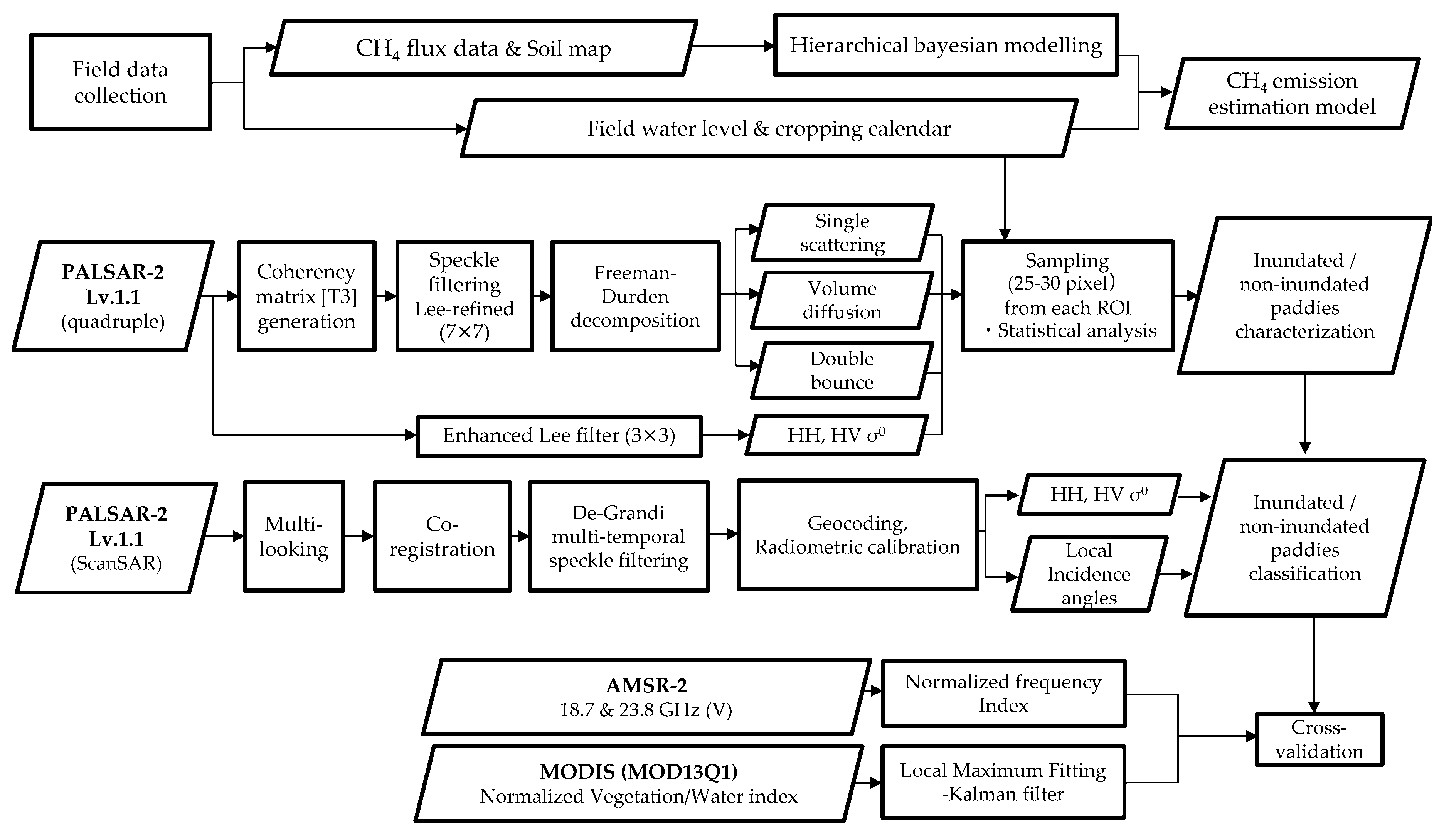
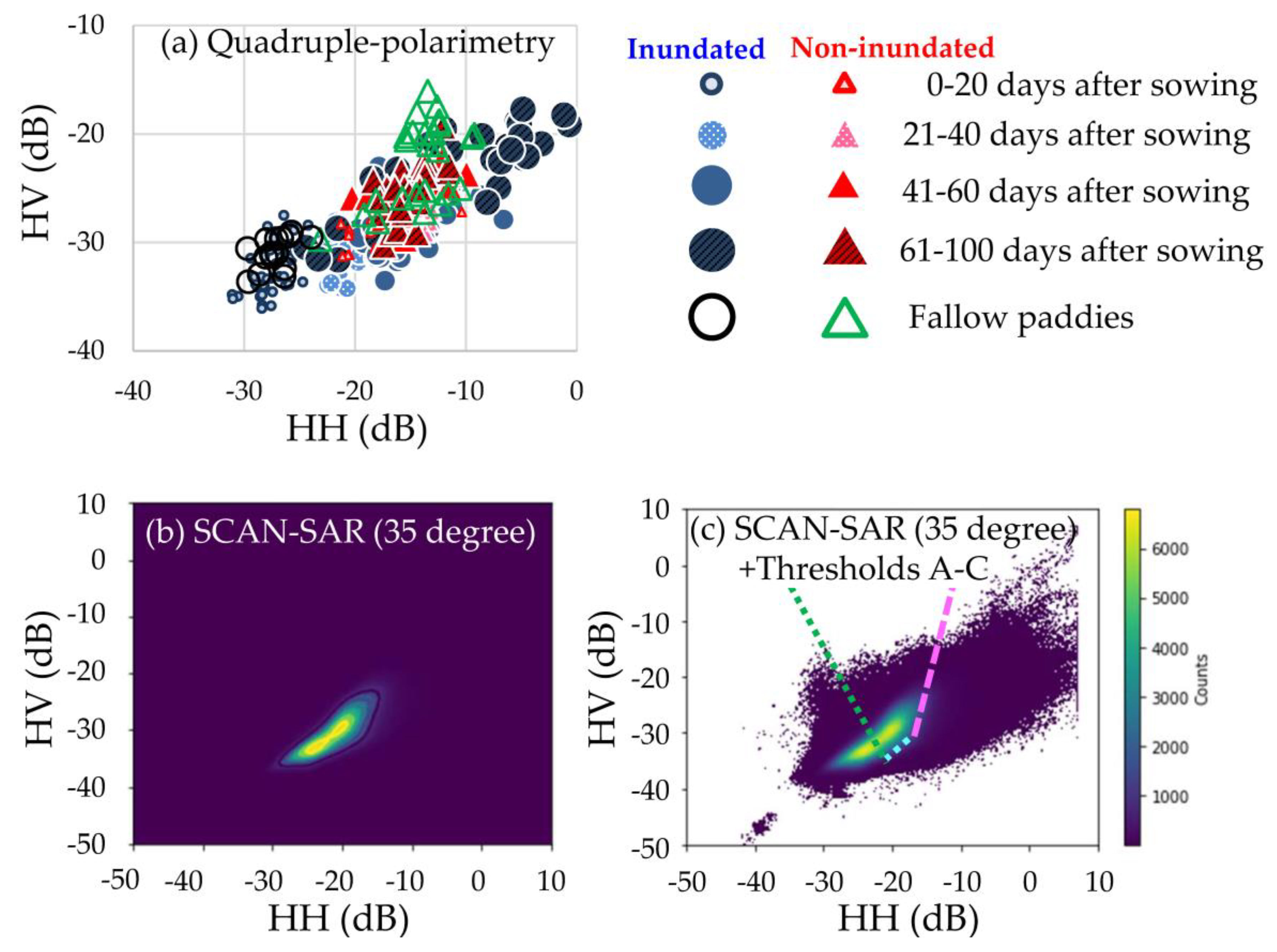

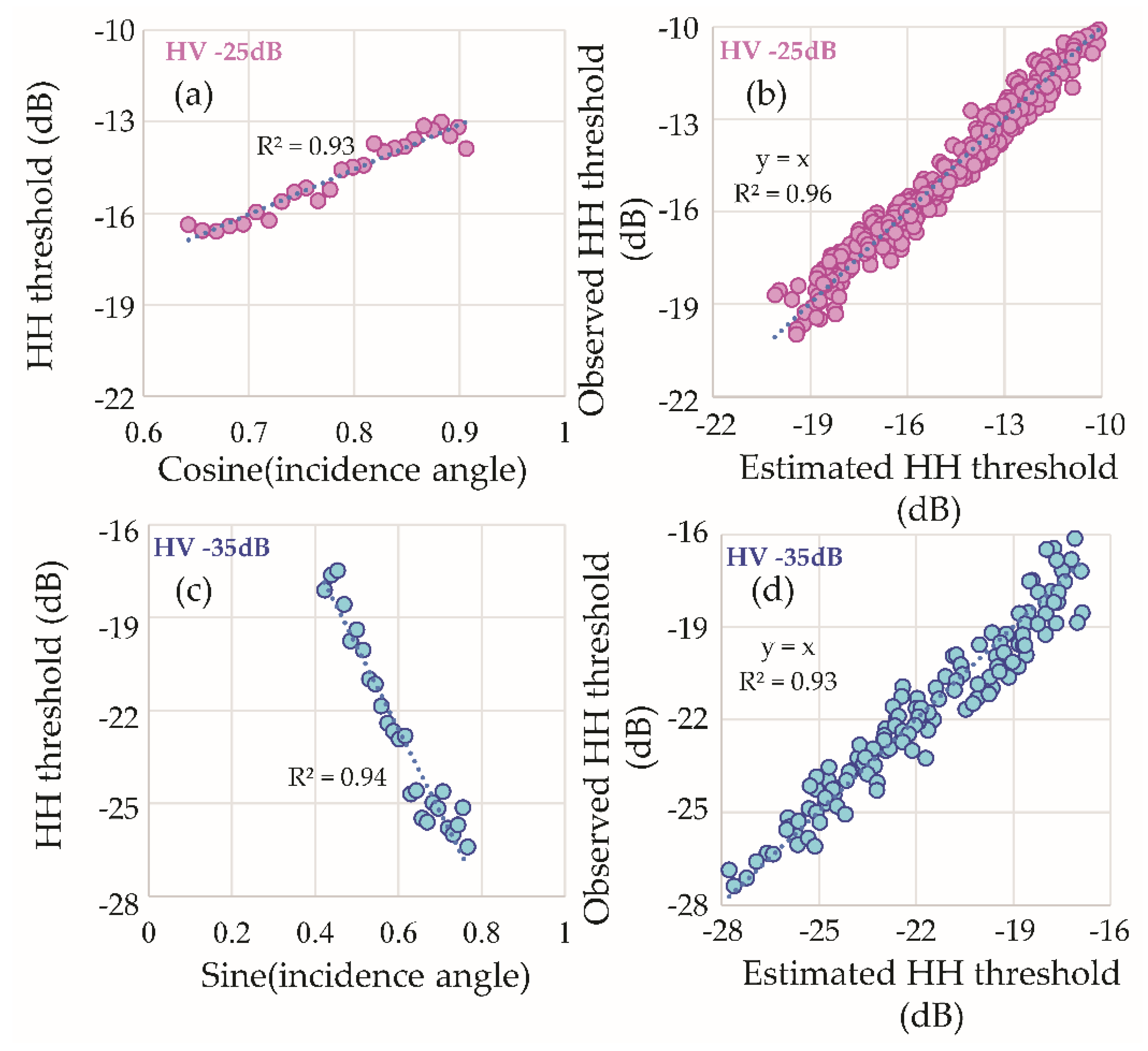

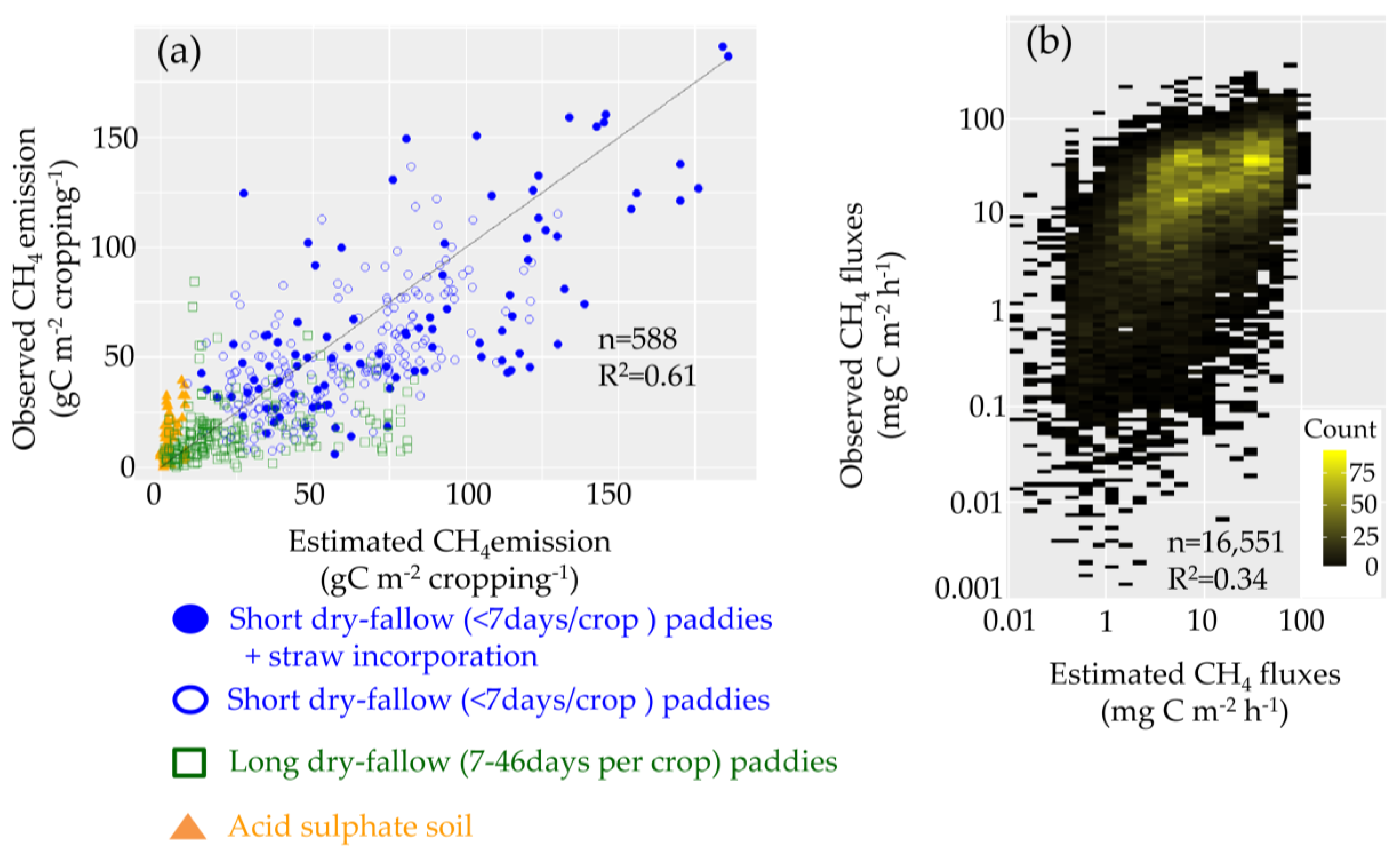
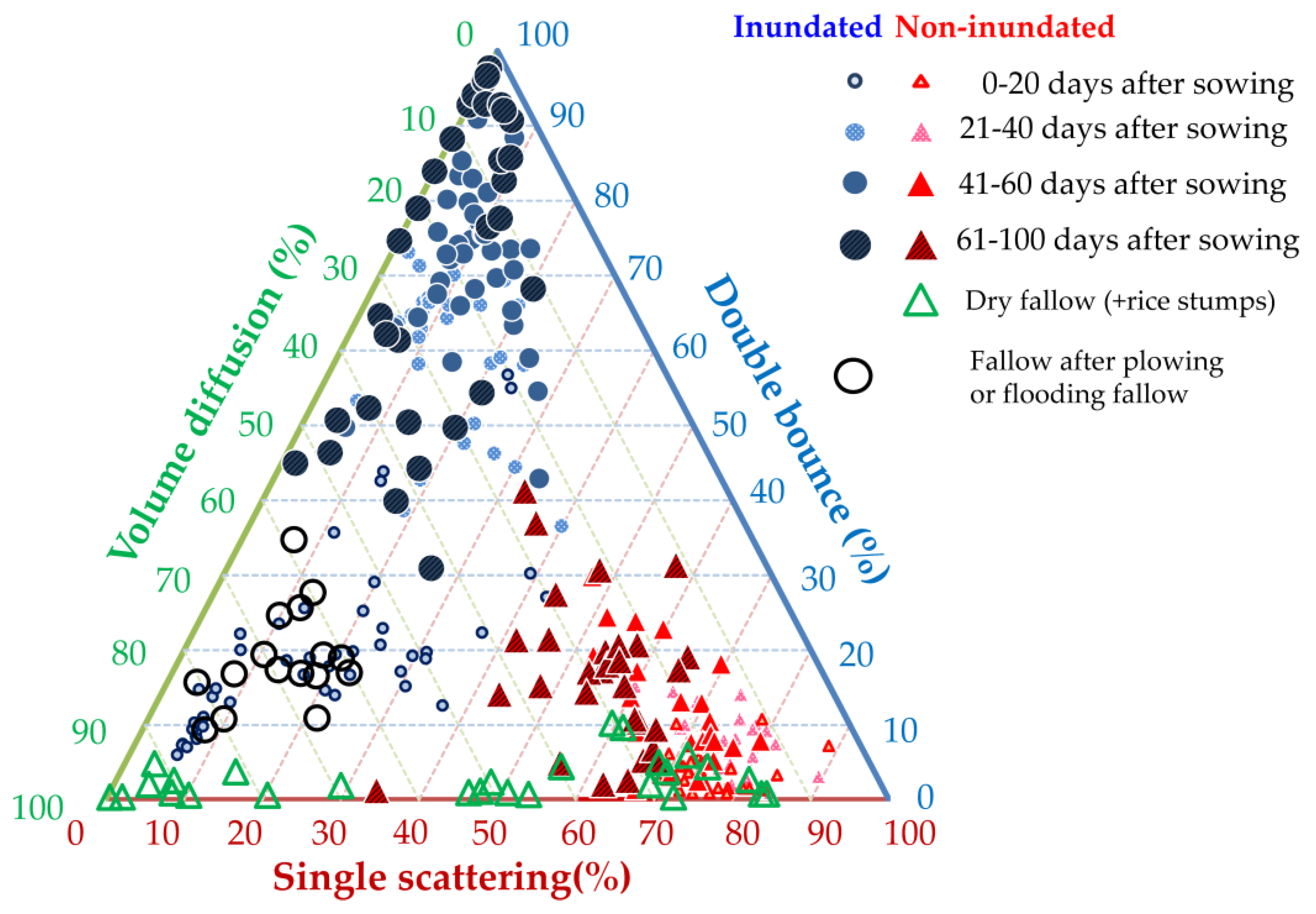
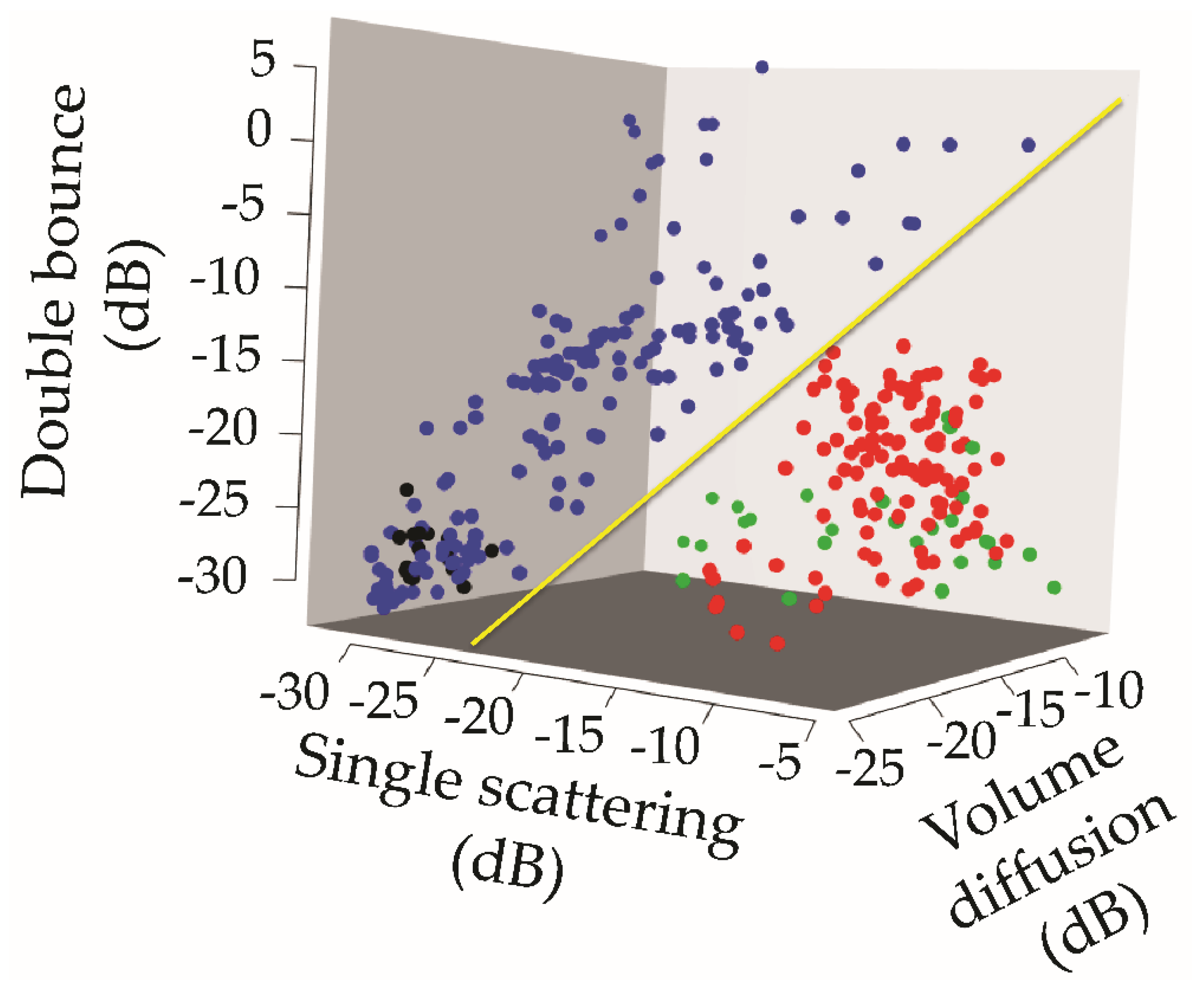
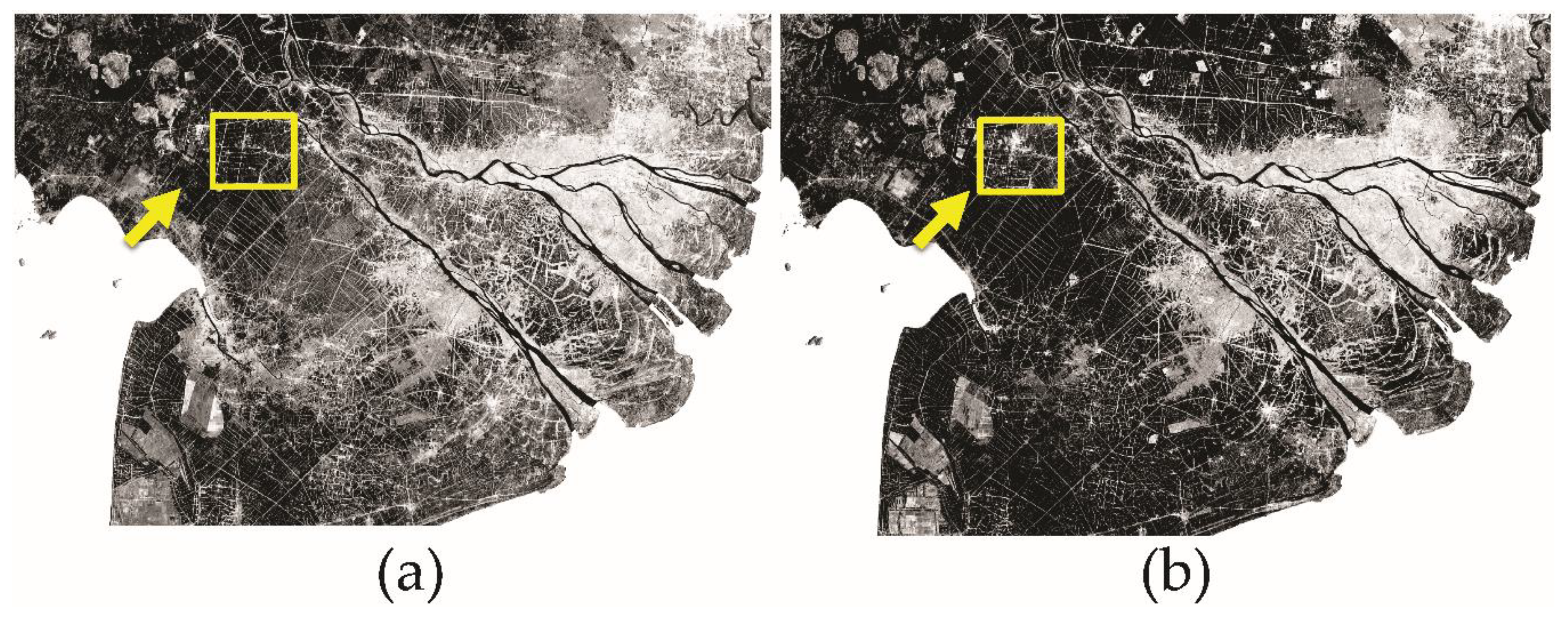
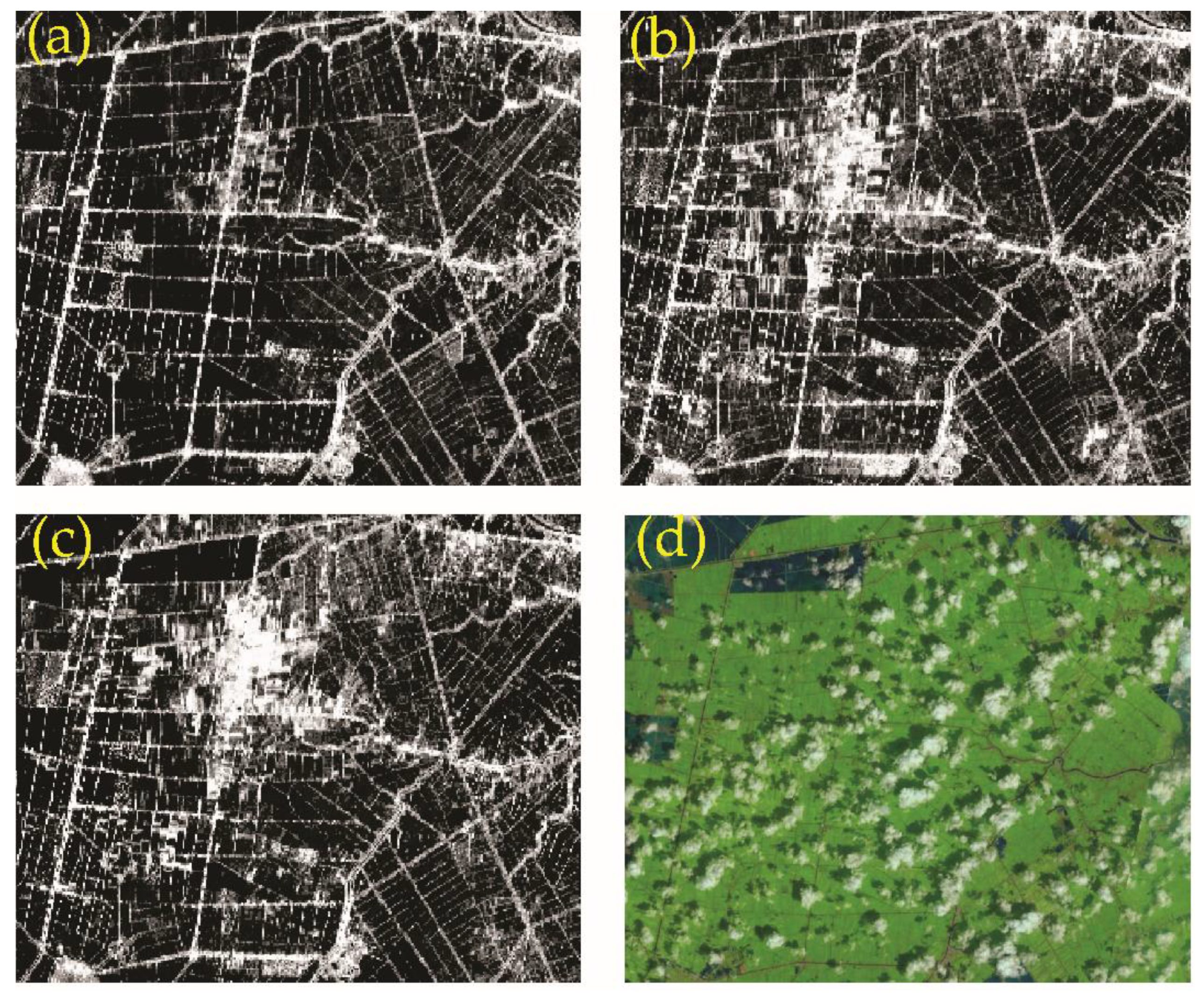
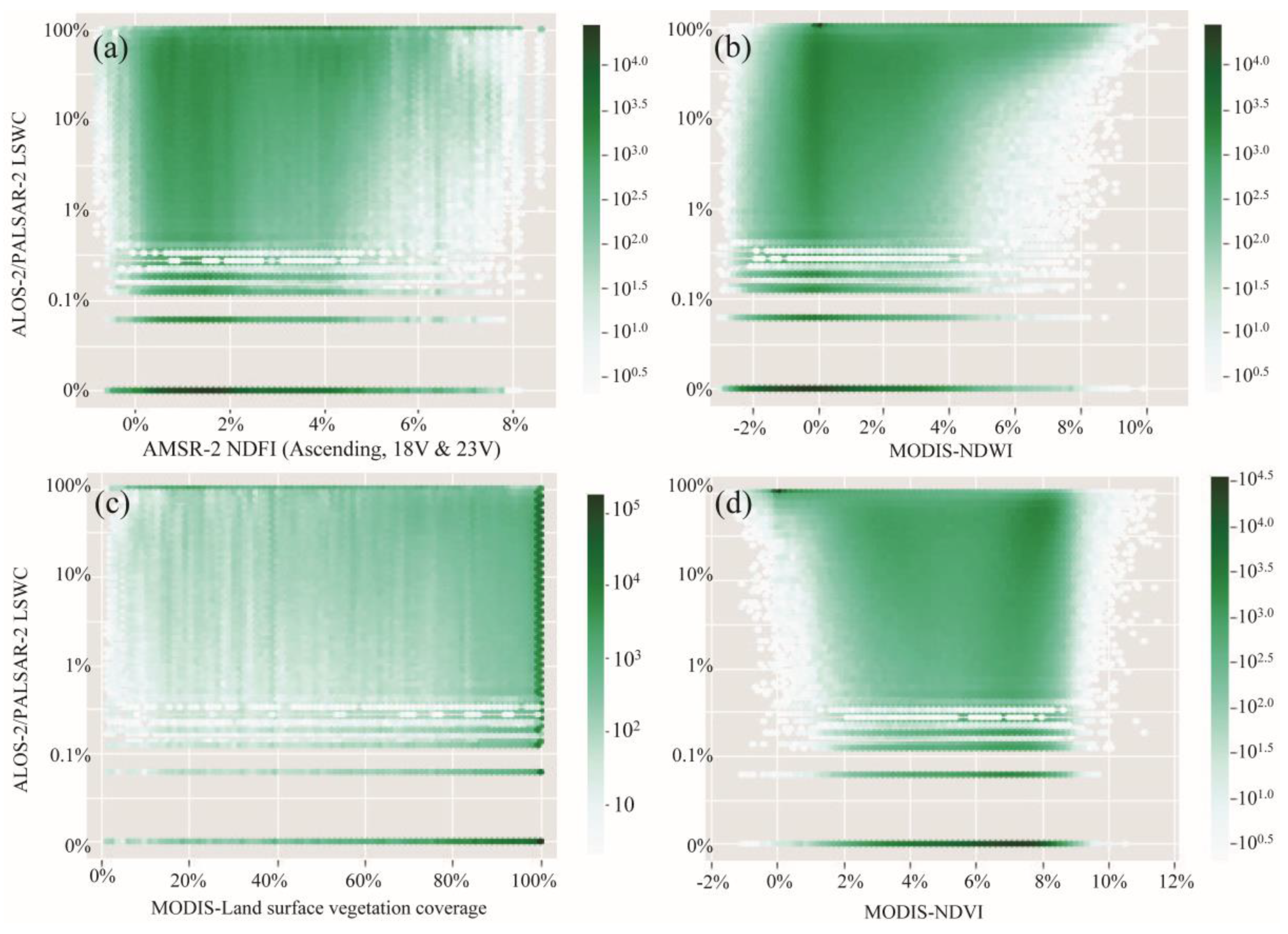
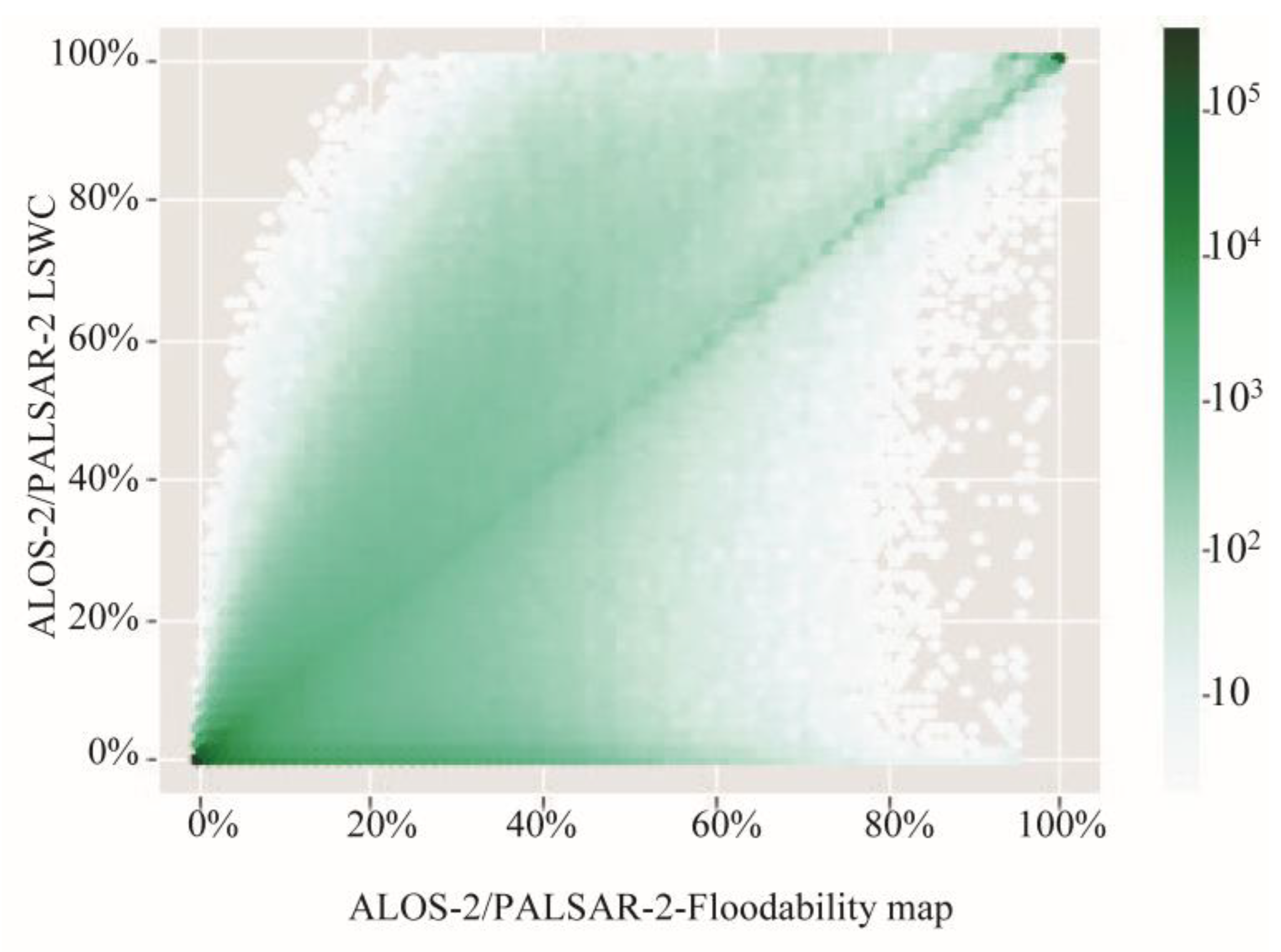
| α | β | γ | δ | ε | ζ | |
|---|---|---|---|---|---|---|
| Mean ± Standard deviation | 2.91 ± 0.83 | 0.027 ± 0.012 | 0.083 ± 0.043 | 0.012 ± 0.008 | 0.43 ± 0.16 | 1.50 ± 1.14 |
| Median | 2.93 | 0.027 | 0.076 | 0.011 | 0.43 | 1.31 |
| η | Θ | ι | κ | λ | μ | ν | ξ | ο | π | |
|---|---|---|---|---|---|---|---|---|---|---|
| Mean ± Standard deviation | 47.7 ± 36.0 | 0.099 ± 0.074 | 0.43 ± 0.26 | 0.019 ± 0.021 | 0.23 ± 0.22 | 1.03 ± 0.75 | 0.20 ± 0.10 | 0.28 ± 0.14 | 1.63 ± 1.57 | 0.00051 ± 0.00021 |
| Median | 42.0 | 0.073 | 0.45 | 0.011 | 0.16 | 0.88 | 0.188 | 0.27 | 1.39 | 0.00051 |
© 2018 by the authors. Licensee MDPI, Basel, Switzerland. This article is an open access article distributed under the terms and conditions of the Creative Commons Attribution (CC BY) license (http://creativecommons.org/licenses/by/4.0/).
Share and Cite
Arai, H.; Takeuchi, W.; Oyoshi, K.; Nguyen, L.D.; Inubushi, K. Estimation of Methane Emissions from Rice Paddies in the Mekong Delta Based on Land Surface Dynamics Characterization with Remote Sensing. Remote Sens. 2018, 10, 1438. https://doi.org/10.3390/rs10091438
Arai H, Takeuchi W, Oyoshi K, Nguyen LD, Inubushi K. Estimation of Methane Emissions from Rice Paddies in the Mekong Delta Based on Land Surface Dynamics Characterization with Remote Sensing. Remote Sensing. 2018; 10(9):1438. https://doi.org/10.3390/rs10091438
Chicago/Turabian StyleArai, Hironori, Wataru Takeuchi, Kei Oyoshi, Lam Dao Nguyen, and Kazuyuki Inubushi. 2018. "Estimation of Methane Emissions from Rice Paddies in the Mekong Delta Based on Land Surface Dynamics Characterization with Remote Sensing" Remote Sensing 10, no. 9: 1438. https://doi.org/10.3390/rs10091438
APA StyleArai, H., Takeuchi, W., Oyoshi, K., Nguyen, L. D., & Inubushi, K. (2018). Estimation of Methane Emissions from Rice Paddies in the Mekong Delta Based on Land Surface Dynamics Characterization with Remote Sensing. Remote Sensing, 10(9), 1438. https://doi.org/10.3390/rs10091438






